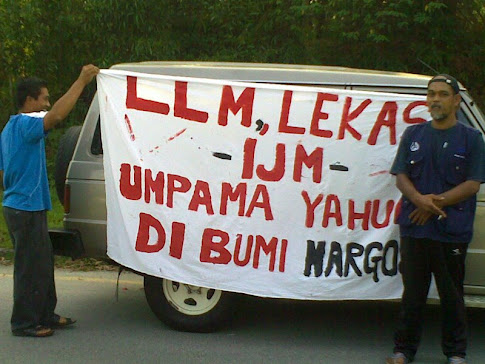Dulu bersama pembangkang duit gaji pun janji tak nak ambil. Kunun nak ikut Tok Guru Nik Aziz. Masuk UMNO balik ini kerja si Pembakar Jambatan
One damning rumour that looms with this is that a close family member of the minister-in-charge Dato’ Seri Utama Dr Rais Yatim has been associated in lobbying for part of the grant for one of the operators bidding. This cannot be true as Dr Rais is a respected senior member of the Cabinet and has been around in the Federal Government since third Prime Minister Tun Hussein Onn’s time (with the exception of the interegnum period between 1987 – 1999). If this rumour is true, then it would be a scandal which Prime Minister Dato’ Seri Mohd. Najib Tun Razak is gravely unable to afford.
Ministry of Information, Communications and Culture (KPPK) via Malaysian Communications and Multimedia Commission (MCMC) was given the task to drive and develop the franework of controls to the access to connectivity. A letter was issued to nine companies on 17 September 2010; Celcom, Maxis, DiGi, U-Mobile, P1, Redtone, YTL, Airspace and Puncak Semangat. Unofficially, they were informed about the allocation to 3G and WiMAX operators for achieving the 50% broadband household penetration rate. The 2.6GHz spectrum would be made available for allocation from 1 January 2013 through apparatus assignment.
The requirement is basic. Operators are required to submit detailed business plan. It was said that no time line was specified. The spectrum available is between 2500MHz and 2690MHz, which should be divided into 9 operators. Each allocated the 20MHz between the bands. The remaining 10MHz will serve as a spare buffer band.
The Long Term Evolution (LTE) technology required from the operators in order to deliver the 100Mbps (Current 3G HSDPA = 7Mps). It is understood that all operators have plans how to roll-out LTE to provide better broadband network to support high end applications and services, which is very much the expectation of the market and consumers.
Never the less, the challenges raised are pertinent and very real. For starters, the allocation of 20 MHz is insufficient to effectively roll-out the LTE. Splitting the spectrum and allocating the 20MHz will not maximise the throughput benefit of the spectrum. In fact it is technically unproductive to do so.
Heavy equipments are required to deliver the 2.6GHz as the capacity loading would be termendous. The concern is that how are the WiMAX operators able to deliver the 2.6GHz when they currently struggling to even deliver 2.3GHz commitments. The operators have the resources and capabilities to maintain the different networks (GSM and 3G). The other question arises from this exercise is that how would the same operators serve the WiMAX network with existing capacity.
The customer base is also a major concern. The current 3G operators have a huge subscriber base. It is technologically and commercially natural for these operators and telecommunication providers progress towards meeting the higher demands and expectation of the subscribers and new consumer markets. It is expected to be sustainably viable too. Would the operators able to sustain the business in long term with the current subscriber base.
3G operators have concerns on the the Government would think and have the propensity to consolidate all the operators with WiMAX or other smaller broadband operators in order to acquire more spectrum. The consolidation, especially with Government’s instruction should be avoided as proven in the past, it would just benefit some parties and has a larger impact and loss to the industry.
To develop the 2.6GHz spectrum, it was said that MCMC is providing a RM 1 billion fund from the Universal Service Provider (USP) fund.
This is taken from the MCMC presentation dated 17 March 2003″
•USP Fund
Contribution – By licensee of 6% of its weighted net revenue. Only by those whose net revenue > RM500,000.
Commission shall maintain proper accounts of the USP Fund – Annual report and statement of accounts
However only three out of the nine companies bidding would benefit from this grant. The three is not ascertained yet at this time.
One damning rumour that looms with this is that a close family member of the minister-in-charge Dato’ Seri Utama Dr Rais Yatim has been associated in lobbying for part of the grant for one of the operators bidding. This cannot be true as Dr Rais is a respected senior member of the Cabinet and has been around in the Federal Government since third Prime Minister Tun Hussein Onn’s time (with the exception of the interegnum period between 1987 – 1999). If this rumour is true, then it would be a scandal which Prime Minister Dato’ Seri Mohd. Najib Tun Razak is gravely unable to afford.
The right way to do this is transparency. The industry is very small. Any movements would be known. More over if it involves grants which are RM hundreds of millions.
Favourtism would simply be detected almost automatically. How the grants would be awarded would create negative perception. It is imperative that the delivery of the 2.6GHz spectrum is done properly to the parties who are deserving and able to follow it through. The challenges arisen from technological, commercial and growth demands for the 100Mbps service will determine how the high value economy that PM Najib’s New Economic Model grand plan is able to be realised. At this point, confidence is very important. Communications is one of the National Key Economic Area focused by the Federal Government.
After all, transparency is what PM Najib promised when he assumed the premiership from PM ‘Flip-Flop’ Dato’ Seri Abdullah Ahmad Badawi on 28 March 2009. Corruption is one of the National Key Result Area which PM Najib’s leadership has to follow through.
Baca Dari blog


